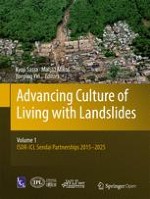Open Access 2017 | Open Access | Book

Advancing Culture of Living with Landslides
Volume 1 ISDR-ICL Sendai Partnerships 2015-2025
Editors: Kyoji Sassa, Matjaž Mikoš, Yueping Yin
Publisher: Springer International Publishing
Open Access 2017 | Open Access | Book

Editors: Kyoji Sassa, Matjaž Mikoš, Yueping Yin
Publisher: Springer International Publishing
This book is open access under a CC BY 4.0 license.
This is a special volume for the ISDR-ICL Sendai Partnerships 2015-2015 for global promotion of understanding and reducing landslide disaster risk which was adopted on 16 March 2015 in the third World Conference on Disaster Risk Reduction, Sendai, Japan. It was signed by 17 global stakeholders including ICL, UNESCO, UNSDR, WMO, ICSU, Governments of Japan, Italy, Croatia.